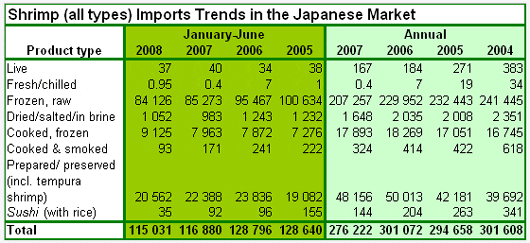Overview
Along with an overall drop in fishery imports, shrimp imports during January-June were also lower than the same period last year. In the domestic economy, high energy and food prices along with declining real wages are affecting Japanese consumer spending, which accounts for an estimated 55% of Japanese GDP. Japanese economic output shrank 0.06% during the second quarter of this year affecting domestic spending on food including fishery products.
Consumption

During January-July 2008, an average household in Japan consumed 4.047 kg of shrimp which is 4.20% less than the same period last year. With the exception of cooked frozen shrimp, imports fell for all other types during this period. The current market situation is a reflection of this trend.
The summer festival (Obon) celebrated during mid-August coincided with the Beijing Olympic games when many stayed indoors to watch the events over television. Business, however, was brisk for the ‘take-away’ catering trade which was in favour of prepared shrimp products.
The post Obon consumption of shrimp was overshadowed by the Doyono usinohi, the annual eel-eating season. This traditional consumption period for eating eel fell between 24 July to 5 August when the intake of kabayaki (roasted eel) and other eel-based food was high throughout Japan.
Imports
During January-June this year, shrimp imports into Japan amount to 115 031 MT with an import value of ¥101.74 billion (US$ 967.78 million) against 116 880 MT and ¥114.35 billion (US$ 940 million) last year. Supplies fell for all product forms except cooked frozen shrimp that registered a 15% growth. Thailand was the leading supplier in over all shrimp imports, accounting for a 22% market share which mostly consisted of higher value products.

The share of raw frozen products in total shrimp imports remained stable at 73% but supplies declined compared to last year. Among the top ten suppliers under this category, imports increased only from Vietnam and Bangladesh.

Japanese import interest slowed down following disappointing sales during the Obon festival. Many factors are not favourable for imports including declining shrimp consumption, yen/dollar fluctuations, rising market prices and competition from western markets.
Offer prices, during the last week of August increased from most sources. High quality black tiger shrimp from India was sold at nearly US$12/kg for 16/20 headless shrimp. Export prices from Indonesia are also firm. Only Vietnam continues to quote lower than the others as many in the industry face cash flow problem and bank interest rates increased to a high of 21% in Vietnam.
During mid September, export prices of frozen shell-on black tiger shrimp from Vietnam came down to US$ 9.80-10.00/kg, CFR Japan, causing confusion in the export market. The situation was mainly linked with the news on food poisoning associated with imported frozen squid from Vietnam. With zero import duty for Indonesian products, demand has improved from this source.
Supply
Supply forecast in Thailand indicated lower harvests of vannamei than last year as many shrimp farmers are shifting from vannamei to tilapia and black tiger shrimp. The Federation of Shrimp Farmers Cooperatives of Thailand has a plan to convert 30% of their shrimp farms (mainly vannamei) to tilapia aquaculture. Export prices of vannamei have gone up from Thailand compared to last year.
In August, heavy rain falls in the southern states of India have affected farming and fishing activities. Raw material prices are moving up, although the Indian rupee has slightly weakened against the US dollar.
Over the last few years, supplies of black tiger shrimp from Myanmar to the Japanese market increased significantly. But this year’s farming has been severely disrupted in Myanmar by the cyclone “Nargis’.
Outlook
The post holiday market is rather slow with more than adequate inventories in Japan. Overall demand for shrimp during the Obon festival was disappointing particularly at the restaurant trade.
The market is rather quiet at present. Restaurant sales during this year’s holiday season was much lower than previous years. Consumer disposable income is largely affected by the rising fuel prices. Shrimp sales to the restaurant trade is affected by the shrinking number of clients at restaurants. Supermarkets continue to promote vannamei, however, there is concern over the rising export prices from the countries of origin. After many years, black tiger shrimp is being promoted by the retail trade this year.
Considering the over all supply and demand situation, global shrimp market is expected to stay firm till end of the year. Imports into Japan may improve to cater for the year-end demand when consumption usually goes up. However, the forecast of “recession in Japan”, might affect household consumption of shrimp which in turn will have a negative impact on the domestic and import trade.
The new Economic Partnership Agreement (EPA) between Japan and Indonesia and subsequent zero import duty on shrimp (effective from 1 July) may facilitate imports from this origin. The same is also applicable for Thailand. Imports may slow down from other countries as offer prices are firm along with lower supplies of raw materials.
October 2008

